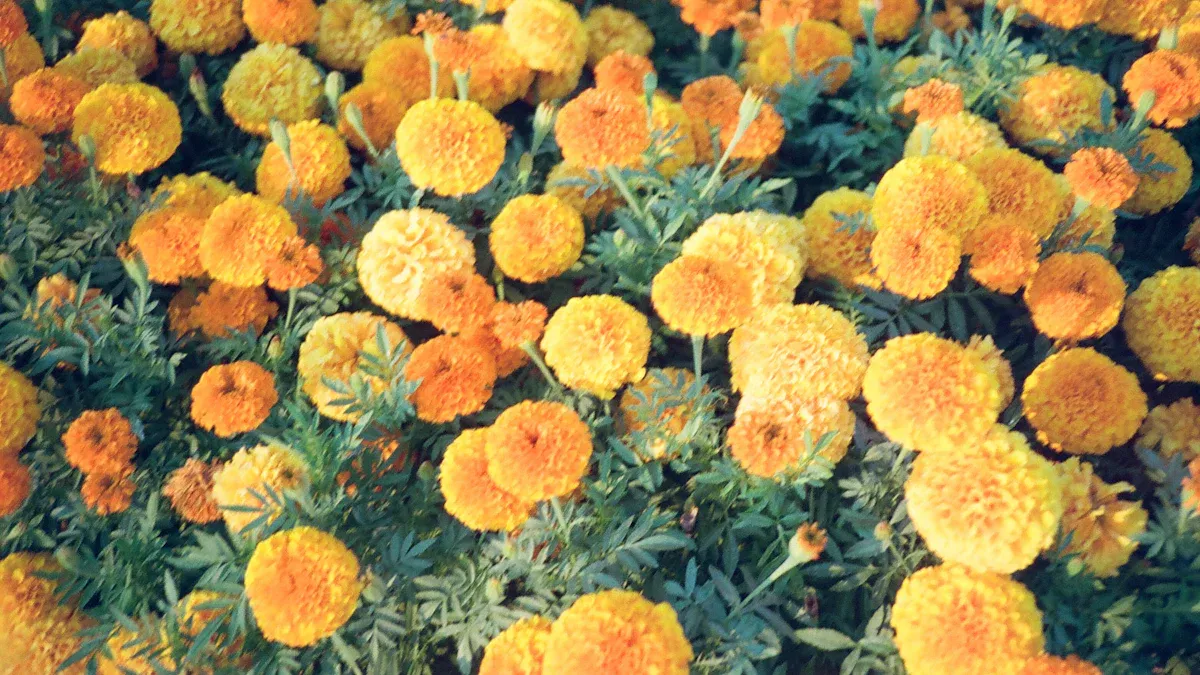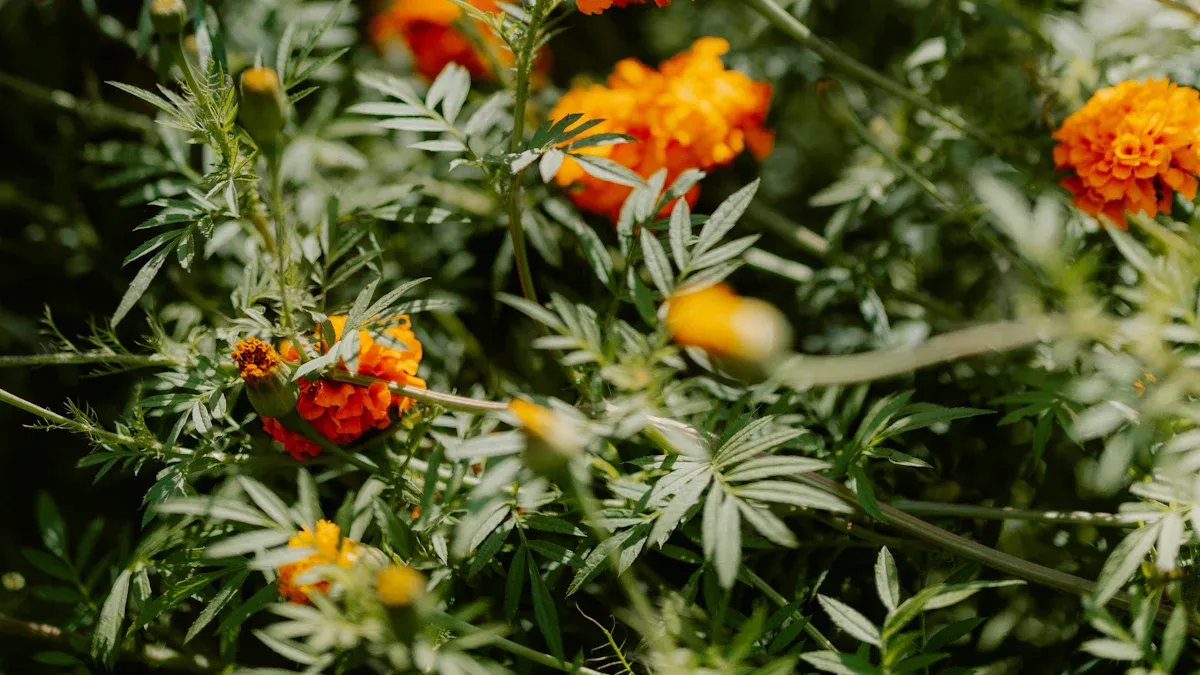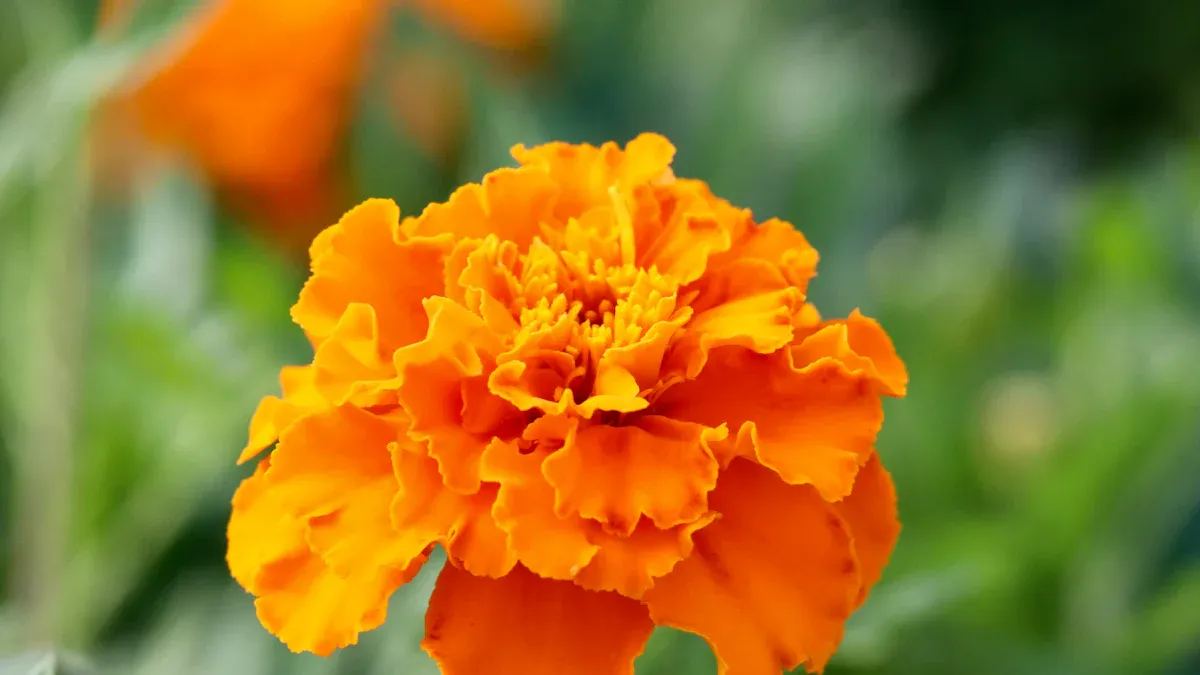
Marigolds add vibrant color and charm to your garden. You likely want these beauties to bloom for as long as possible. Did you know that marigolds typically bloom for about 8 to 10 weeks from seed germination? By understanding their specific needs and care techniques, you can keep marigolds blooming longer and enjoy their cheerful presence throughout the season.
Key Takeaways
Provide marigolds with at least 5 hours of direct sunlight each day to promote healthy blooming.
Use well-draining soil and apply liquid fertilizers regularly to ensure your marigolds receive essential nutrients.
Deadhead spent flowers weekly to encourage new blooms and keep your marigolds vibrant throughout the season.
Marigold Needs
Sunlight Requirements
To keep marigolds blooming, you must pay attention to their sunlight needs. Marigolds thrive in full sun, requiring at least 5 hours of direct sunlight daily for optimal blooming. If you’re growing them indoors or in shaded areas, consider using a strong grow light that mimics this sunlight. 🌞 This ensures your marigolds receive the energy they need to produce those vibrant flowers you love.
Soil Conditions
The right soil conditions play a crucial role in the health and blooming of marigolds. They prefer well-draining soil rich in organic matter. Here are some tips to enhance your soil:
Use a liquid fertilizer with a lower nitrogen number and higher levels of phosphorous and potassium.
Phosphorous is essential for developing larger blooms and flower buds.
Potassium supports overall plant health, making your marigolds more resilient to heat and drought.
Additionally, marigolds can act as green manure. After their growing season, they enrich the soil with nutrients. Their deep root systems help aerate the soil, improving water infiltration and drainage, especially in compacted clay-heavy soils. By ensuring your marigolds have the right sunlight and soil conditions, you set the stage for a longer blooming period.
Keep Marigolds Blooming with Fertilization

Fertilization is key to keeping marigolds blooming longer. Using the right type of fertilizer can make a big difference in how vibrant and plentiful your flowers are. One of the best options is liquid fertilizers.
Benefits of Liquid Fertilizers
Liquid fertilizers offer several advantages over granular types. Here’s why you should consider them:
Quick Absorption: Liquid fertilizers are absorbed quickly by the plants. This means your marigolds get immediate nutrients, which helps them bloom faster.
Frequent Application: You can apply liquid fertilizers more often at a diluted strength. This ensures a steady supply of nutrients, promoting continuous blooming.
Better Nutrient Delivery: Unlike granular fertilizers, which release nutrients slowly, liquid fertilizers provide a more immediate boost, especially when your marigolds need it most.
How to Select the Right Fertilizer
Choosing the right fertilizer can be overwhelming, but it doesn’t have to be. Here are some tips to help you pick the best one for your marigolds:
Look for a balanced fertilizer with an N-P-K ratio suitable for flowering plants. A higher phosphorus ratio, like 15-30-15, is ideal for enhancing blooms.
Consider using a 10-10-10 synthetic granular fertilizer at planting time. This gives your marigolds a good start.
For ongoing care, a 5-10-5 slow-release granular fertilizer every four to six weeks during the growing season can keep your plants healthy and blooming.
Here’s a quick table summarizing the nutrients you should look for in your liquid fertilizer:
Nutrient | Percentage |
|---|---|
Total Nitrogen (N) | 2% |
Available Phosphate (P2O5) | 3% |
Soluble Potash (K2O) | 2% |
Application Methods
Applying fertilizer correctly is just as important as choosing the right one. Here’s how to do it effectively:
Frequency: Feed your marigolds every ten to fourteen days during the growing season. Regular feeding is crucial for producing new blooms and maintaining plant health.
Dilution: When using liquid fertilizer, apply it at half strength. This prevents over-fertilization, which can harm your plants.
Watering: Always water your marigolds before applying fertilizer. This helps the nutrients soak into the soil and reach the roots more effectively.
By following these fertilization tips, you can keep marigolds blooming longer and enjoy their beauty throughout the season.
The Importance of Deadheading

What is Deadheading?
Deadheading is the process of removing spent flowers from your marigolds. This simple act plays a crucial role in keeping your plants healthy and vibrant. When you deadhead, you help your marigolds focus their energy on producing new blooms instead of seeds. This practice encourages continuous flowering, leading to a greater number of blooms throughout the season. Here’s why deadheading is so important:
It redirects the plant’s energy from seed production to creating new flowers.
Removing faded blooms helps the plant concentrate on producing more buds.
It contributes to a healthier plant by reducing energy spent on seed production.
How to Deadhead Properly
Deadheading marigolds is easy and can be done quickly without any special tools. Follow these steps for the best results:
Check Weekly: Inspect your marigolds once a week for any fading flowers. Removing them promptly encourages continuous blooming.
Pinch the Stem: To deadhead properly, pinch the stem right behind the flower and seed head. This stops the plant from sending energy to the dying flower.
Remove Spent Blooms: Gently pull off the old blooms. This helps conserve energy and promotes new growth.
Repeat Regularly: For optimal results, make deadheading a regular part of your gardening routine. If you want to harvest seeds, stop deadheading about a month before the first expected frost.
By following these steps, you can keep marigolds blooming longer and enjoy their bright palette for an extended period. Remember, deadheading is one of the best ways to ensure strong and consistent blooms in your garden!
Watering Practices
Frequency and Amount
Watering your marigolds correctly is essential for their health and blooming. During the peak blooming season, mature marigolds need about 1 inch of water each week. You can achieve this through rainfall or supplemental watering. To keep your plants thriving, check the soil moisture regularly. If the top inch of soil feels dry, it’s time to water.
Inconsistent watering can stress your marigolds. When they experience irregular moisture levels, they conserve energy and moisture. This stress response can halt new bloom production, as the plant prioritizes survival over flowering. So, aim for a consistent watering schedule to keep those blooms coming!
Signs of Overwatering
While watering is crucial, too much can harm your marigolds. Here are some visual signs that you might be overwatering:
Yellowing leaves
Soggy soil
Wilting despite wet soil
Soft, brown roots
Overwatering can lead to root rot, which weakens your plants and reduces blooming. If you notice these signs, cut back on watering. Allow the soil to dry out between waterings to promote healthy root growth. Remember, healthy roots lead to vibrant blooms!
By following these watering practices, you can ensure your marigolds stay hydrated without drowning, helping them bloom longer and brighter throughout the season. 🌼
Pest and Disease Management
Common Pests
Keeping your marigolds blooming longer means staying vigilant against pests. Here are some common culprits that can reduce your marigolds’ blooming potential:
Knot root nematodes
Tomato hornworms
Cabbage worms
Thrips
Squash bugs
Whiteflies
Aphids
Japanese beetles
Snails
Spider mites
These pests can wreak havoc on your plants, leading to stunted growth and fewer blooms.
Preventative Measures
You can take several steps to protect your marigolds from these pesky invaders. Here are some effective preventative measures:
Companion Planting: Marigolds naturally repel pests. Plant them alongside tomatoes to deter aphids and tomato hornworms. Surround cucumber plants with marigolds to keep cucumber beetles at bay.
Attract Beneficial Insects: Marigolds draw in helpful insects like ladybugs and lacewings. These beneficial bugs feast on harmful pests, keeping your marigolds safe.
Soil Health: Enrich your soil with compost or well-rotted manure. Healthy soil supports strong plants, making them less susceptible to pests.
Regular Maintenance: Deadheading spent flowers encourages continuous blooming. This practice not only keeps your garden looking tidy but also helps your marigolds focus on producing new blooms instead of seeds.
Natural Pest Control: Use insecticidal soap or neem oil to manage pest populations. These organic options are effective and safe for your plants.
By implementing these strategies, you can create a thriving environment for your marigolds, ensuring they bloom beautifully all season long! 🌼
To keep your marigolds blooming longer, focus on these key techniques:
Ensure they get 5 hours of sunlight daily.
Use well-draining soil and appropriate fertilizers.
Regularly deadhead spent blooms to encourage new growth.
Water consistently, avoiding overwatering.
By following these steps, you not only enhance your garden’s beauty but also promote biodiversity. Marigolds attract pollinators and beneficial insects while repelling harmful pests. 🌼 Enjoy a vibrant garden filled with blooming marigolds all season long!
FAQ
How often should I water my marigolds?
Water your marigolds about once a week, ensuring the soil stays moist but not soggy. Check the top inch of soil for dryness. 💧
What pests should I watch for?
Keep an eye out for aphids, spider mites, and whiteflies. These pests can harm your marigolds and reduce blooming. 🐞
Can I grow marigolds in pots?
Absolutely! Marigolds thrive in pots. Just ensure they have enough sunlight and well-draining soil for healthy growth. 🌼

